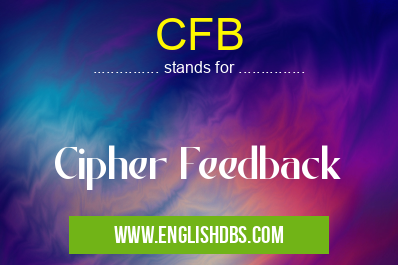What does CFB mean in GENERAL
CFB (Cipher Feedback) is a block cipher mode of operation that utilizes the output of a previous encryption step as the input for the next encryption step. This creates a feedback loop that enhances security by making the encryption process dependent on the ciphertext generated in earlier steps.

CFB meaning in General in Computing
CFB mostly used in an acronym General in Category Computing that means Cipher Feedback
Shorthand: CFB,
Full Form: Cipher Feedback
For more information of "Cipher Feedback", see the section below.
How CFB Works
- Initialization: An Initialization Vector (IV) is generated randomly and encrypted using the cipher.
- Encryption:
- The plaintext is divided into blocks of equal size.
- The first block is XORed with the encrypted IV.
- The result is encrypted, and the ciphertext becomes the feedback.
- Subsequent blocks are XORed with the previous ciphertext and encrypted.
- Decryption:
- The ciphertext is XORed with the encrypted IV to recover the first plaintext block.
- The following ciphertext blocks are XORed with the previous ciphertext blocks to recover the plaintext.
Advantages of CFB
- Error propagation: Errors in the ciphertext affect subsequent decryption steps, making it harder for attackers to recover plaintext.
- Parallelism: CFB can be parallelized, allowing for faster encryption and decryption.
- Random access: It supports random access to ciphertext blocks, enabling efficient decryption of specific parts of the message.
Disadvantages of CFB
- Initialization overhead: The initialization process requires the encryption of an additional block.
- Initialization vector exposure: The IV must be kept secret and unique to prevent attacks.
Essential Questions and Answers on Cipher Feedback in "COMPUTING»GENERALCOMP"
What is Cipher Feedback (CFB)?
Cipher Feedback (CFB) is a block cipher mode of operation that uses a feedback mechanism to generate a stream of pseudorandom data. It is used to encrypt and decrypt data in a secure manner.
How does CFB work?
CFB operates by encrypting a randomly generated value, known as the Initialization Vector (IV), and then feeding the ciphertext back into the encryption algorithm along with the plaintext. This process is repeated for each block of plaintext, resulting in a stream of encrypted data.
What are the advantages of using CFB?
CFB offers several advantages, including:
- Error propagation: Errors in encrypted data are not propagated to subsequent blocks, ensuring data integrity.
- Parallelizability: The encryption of different blocks can be performed independently, making CFB suitable for parallel processing.
- Stream-like operation: CFB produces a stream of encrypted data that can be processed incrementally.
What are the disadvantages of using CFB?
The main disadvantage of CFB is its high overhead, as it requires the generation of a new IV for each encryption operation. Additionally, the use of a feedback mechanism makes CFB susceptible to certain types of attacks.
Where is CFB commonly used?
CFB is widely used in various applications, including:
- Secure network communication
- Disk encryption
- Data protection in smart cards and other embedded devices
Final Words: CFB is a secure and versatile block cipher mode that offers advantages such as error propagation and parallelism. It is commonly used in applications that require strong encryption, such as secure messaging and file encryption. While it has some disadvantages, CFB remains a popular choice for protecting sensitive data.
CFB also stands for: |
|
| All stands for CFB |
